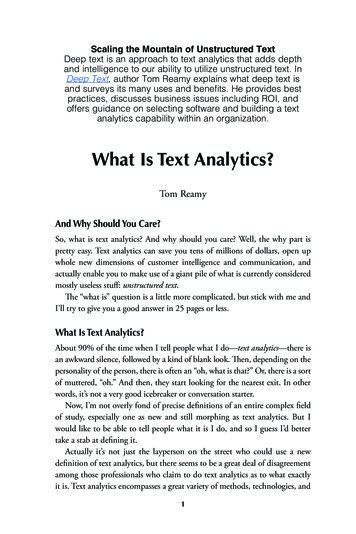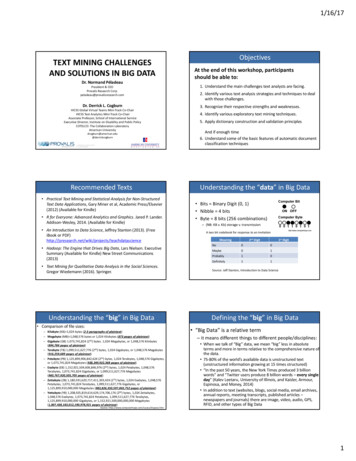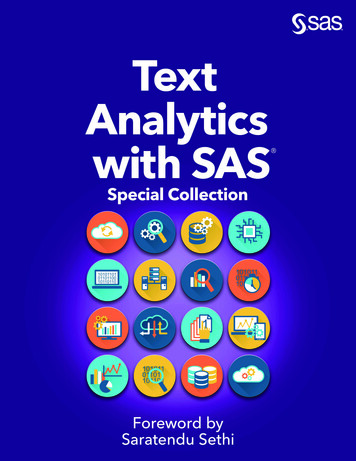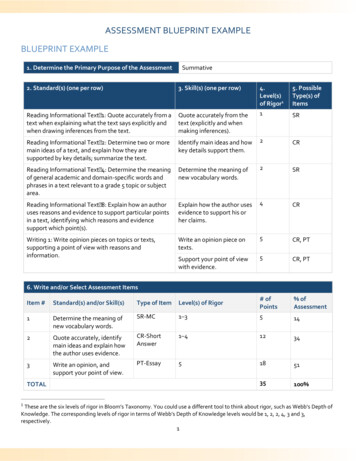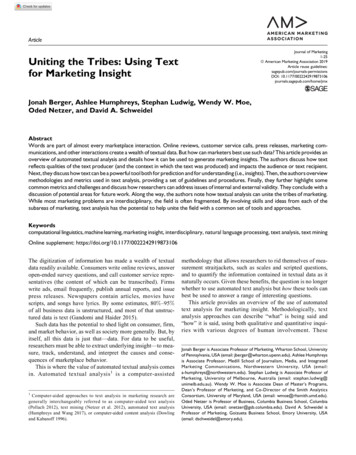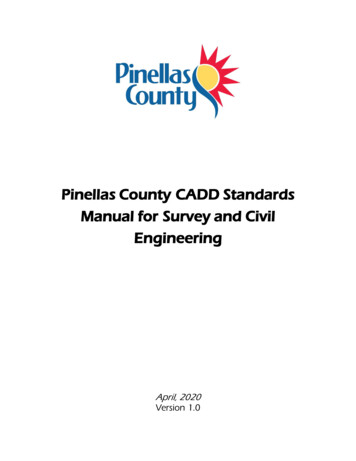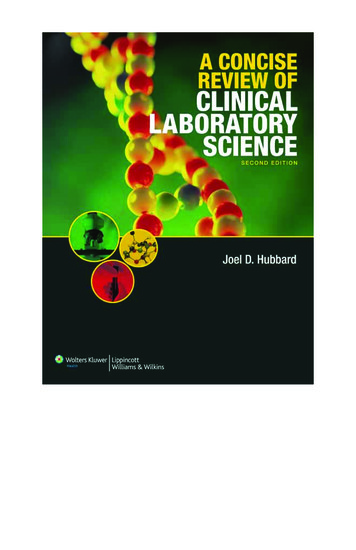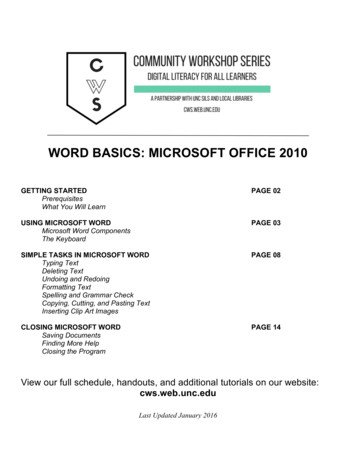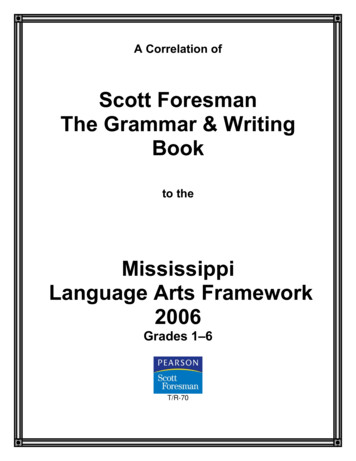
Transcription
CentripetalText: An Efficient Text InstanceRepresentation for Scene Text DetectionTao Sheng, Jie Chen, Zhouhui Lian Wangxuan Institute of Computer TechnologyPeking University, Beijing, China{shengtao, jiechen01, lianzhouhui}@pku.edu.cnAbstractScene text detection remains a grand challenge due to the variation in text curvatures, orientations, and aspect ratios. One of the hardest problems in this task is howto represent text instances of arbitrary shapes. Although many methods have beenproposed to model irregular texts in a flexible manner, most of them lose simplicityand robustness. Their complicated post-processings and the regression under Diracdelta distribution undermine the detection performance and the generalizationability. In this paper, we propose an efficient text instance representation namedCentripetalText (CT), which decomposes text instances into the combination oftext kernels and centripetal shifts. Specifically, we utilize the centripetal shifts toimplement pixel aggregation, guiding the external text pixels to the internal textkernels. The relaxation operation is integrated into the dense regression for centripetal shifts, allowing the correct prediction in a range instead of a specific value.The convenient reconstruction of text contours and the tolerance of predictionerrors in our method guarantee the high detection accuracy and the fast inferencespeed, respectively. Besides, we shrink our text detector into a proposal generationmodule, namely CentripetalText Proposal Network (CPN), replacing SegmentationProposal Network (SPN) in Mask TextSpotter v3 and producing more accurateproposals. To validate the effectiveness of our method, we conduct experimentson several commonly used scene text benchmarks, including both curved andmulti-oriented text datasets. For the task of scene text detection, our approachachieves superior or competitive performance compared to other existing methods,e.g., F-measure of 86.3% at 40.0 FPS on Total-Text, F-measure of 86.1% at 34.8FPS on MSRA-TD500, etc. For the task of end-to-end scene text recognition, ourmethod outperforms Mask TextSpotter v3 by 1.1% in F-measure on Total-Text.1IntroductionIn the past decade, scene text detection has attracted increasing interests in the computer visioncommunity, as localizing the region of each text instance in natural images with high accuracy is anessential prerequisite for many practical applications such as blind navigation, scene understanding,and text retrieval. With the rapid development of object detection [29, 19, 7, 18] and segmentation [22,46, 26, 50], many promising methods [51, 23, 37, 16, 38, 39] have been proposed to solve theproblem. However, scene text detection is still a challenging task due to the variety of text curvatures,orientations, and aspect ratios.How to represent text instances in real imagery is one of the major challenges for scene text detection,and usually there are two strategies to solve the problem arising from this challenge. The first isto treat text instances as a specific kind of object and use rotated rectangles or quadrangles for Corresponding author35th Conference on Neural Information Processing Systems (NeurIPS 2021).
description. This kind of methods are typically inherited from generic object detection and oftenutilize manually designed anchors for better regression. Obviously, this solution ignores the geometrictraits of irregular texts, which may introduce considerable background noises, and furthermore, itis difficult to formulate appropriate anchors to fit the texts of various shapes. The other strategy isto decompose text instances into several conceptual or physical components, and reconstruct thepolygonal contours through a series of indispensable post-processing steps. For example, PAN [38]follows the idea of clustering and aggregates text pixels according to the distances between theirembeddings. In TextSnake [23], text instances are represented by text center lines and ordereddisks. Consequently, these methods are more flexible and more general than the previous ones inmodeling. Nevertheless, most of them suffer from slow inference speed, due to complicated postprocessing steps, essentially caused by this kind of tedious multi-component-based representationstrategy. For another, their component prediction is modeled as a simple Dirac delta distribution,which strictly requires numerical outputs to reach the exact positions and thus weakens the ability totolerate mistakes. The wrong component prediction will propagate errors to heuristic post-processingprocedures, making the rebuilt text contours inaccurate. Based on the above observations, we can findout that the implementation of a fast and accurate scene text detector heavily depends on a simplebut effective text instance representation with a robust post-processing algorithm, which can tolerateambiguity and uncertainty.To overcome these problems, we propose an efficient component-based representation methodnamed CentripetalText (CT) for arbitrary86shaped texts. Enabled by the proposed CT, our85scene text detector outperforms other state-of84the-art approaches and achieves the best tradeoff between accuracy and speed (as shown in83Fig. 1). Specifically, as illustrated in Fig. 4,82our method consists of two steps: i) input im81ages are fed to the convolutional neural networkto predict the probability maps and centripetal80shift maps. ii) pixels are grouped to form theSpeed (FPS)255075100text instances through the heuristics based ontext kernels and centripetal shifts. In details,Figure 1: Performance and speed of some top- the text kernels are generated from the probabilperforming real-time scene text detectors on the ity map followed by binarization and connectedTotal-Text dataset. Enabled by the proposed CT, component search, and the centripetal shifts arean efficient representation of text instances, our predicted at each position of the centripetal shiftmethod outperforms DB [16] and PAN [38], and map. Then each pixel is shifted by the amount ofachieves the best trade-off between accuracy and its centripetal shift from its original position inspeed. More results are shown in Tab. 3.the centripetal shift map to the text kernel pixelor background pixel in the probability map. Allpixels that can be shifted into the region of the same text kernel form a text instance. In this manner,we can reconstruct the final text instances fast and easily through marginal matrix operations andseveral calls to functions of the OpenCV library. Moreover, we develop an enhanced regression loss,namely the Relaxed L1 Loss, mainly for dense centripetal shift regression, which further improvesthe detection precision. Benefiting from the new loss, our method is robust to the prediction errors ofcentripetal shifts because the centripetal shifts which can guide pixels to the region of the right textkernel are all regarded as positive. Besides, CT can be fused with CNN-based text detectors or spottersin a plug-and-play manner. We replace SPN in Mask TextSpotter v3 [13] with our CentripetalTextProposal Network (CPN), a proposal generation module based on CT, which produces more accurateproposals and improves the end-to-end text recognition performance further.CT-640CT-512PAN-640CT (ours)F-measure (%)PAN-512DB-ResNet50PAN (2019)DB (2020)DB-ResNet18CT-320PAN-320To evaluate the effectiveness of the proposed CT and Relaxed L1 Loss, we adopt the design ofnetwork architecture in PAN [38] and train a powerful end-to-end scene text detector by replacingits text instance representation and loss function with ours. We conduct extensive experiments onthe commonly used scene text benchmarks including Total-Text [2], CTW1500 [47], and MSRATD500 [45], demonstrating that our method achieves superior or competitive performance comparedto the state of the art, e.g., F-measure of 86.3% at 40.0 FPS on Total-Text, F-measure of 86.1% at34.8 FPS on MSRA-TD500, etc. For the task of end-to-end text recognition, equipped with CPN, the2
F-measure value of Mask TextSpotter v3 can further be boosted to 71.9% and 79.5% without andwith lexicon, respectively.Major contributions of our work can be summarized as follows: We propose a novel and efficient text instance representation method named CentripetalText,in which text instances are decomposed into the combination of text kernels and centripetalshifts. The attached post-processing algorithm is also simple and robust, making thegeneration of text contours fast and accurate. To reduce the burden of model training, we develop an enhanced loss function, namely theRelaxed L1 Loss, mainly for dense centripetal shift regression, which further improves thedetection performance. Equipped with the proposed CT and the Relaxed L1 Loss, our scene text detector achievessuperior or competitive results compared to other existing approaches on the curved ororiented text benchmarks, and our end-to-end scene text recognizer surpasses the currentstate of the art.2Related workText instance representation methods can be roughly classified into two categories: component-freemethods and component-based methods.Component-free methods treat every text instance as a complete whole and directly regress therotated rectangles or quadrangles for describing scene texts without any reconstruction process.These methods are usually inspired by general object detectors such as Faster R-CNN [29] andSSD [19], and often utilize heuristic anchors as prior knowledge. TextBoxes [15] successfullyadapted the object detection framework SSD for text detection by modifying the aspect ratios ofanchors and the kernel scales of filters. TextBoxes [14] and EAST [51] could predict eitherrotated rectangles or quadrangles for text regions with and without the prior knowledge of anchors,respectively. SPCnet [40] modified Mask R-CNN [7] by adding the semantic segmentation guidanceto suppress false positives.Component-based methods prefer to model text instances from local perspectives and decomposeinstances into components such as characters or text fragments. SegLink [31] decomposed long textsinto locally-detectable segments and links, and combined the segments into whole words accordingto the links to get final detection results. MSR [43] detected scene texts by predicting dense textboundary points. BR [30] further improved MSR by regressing the positions of boundary points fromtwo opposite directions. PSENet [37] gradually expanded the detected areas from small kernels tocomplete instances via a progressive scale expansion algorithm.3MethodologyIn this section, we first introduce our new representation (i.e., CT) for texts of arbitrary shapes. Then,we elaborate on our method and training details.3.1RepresentationOverview An efficient scene text detector must have a well-defined representation for text instances.The traditional description methods inherited from generic object detection (e.g., rotated rectangles orquadrangles) fail to encode the geometric properties of irregular texts. To guarantee the flexibility andgenerality, we propose a new method named CentripetalText, in which text instances are composedof text kernels and centripetal shifts. As demonstrated in Fig. 2, our CT expresses a text instance as acluster of the pixels which can be shifted into the region of the same text kernel through centripetalshifts. As pixels are the basic units of digital images, CT has the ability to model different forms oftext instances, regardless of their shapes and lengths.Mathematically, given an input image I, the ground-truth annotations are denoted as {T1 , T2 , ., Ti , .},where Ti stands for the ith text instances. Each text instance Ti has its corresponding text kernel Ki ,a shrunk version of the original text region. Since a text kernel is a subset of its text instance, which3
Text KernelText Regionor: Centripetal ShiftFigure 2: Illustration of the proposed CentripetalText representation. Text regions (in yellow) can bedecomposed into the combination of text kernels (in blue) and centripetal shifts (either in red or green).The centripetal shifts represented as green arrows start from background pixels to non-text-kernelpixels, which are useless for the further generation of text contours, while other centripetal shifts inred start from text region (foreground) pixels to text kernel pixels, which contribute to define theshapes. All the pixels that can be shifted into the region of the same text kernel form a text instance.For the sake of better demonstration, we only visualize the centripetal shifts over the bottom textinstance.satisfies Ki Ti , we treat it as the main basic of the pixel aggregation. Different against the distancein conventional methods, each centripetal shift sj which appears in a position pj of the image guidesthe clustering of text pixels. In this sense, the text instance Ti can be easily represented with theaggregated pixels which can be shifted into the region of a text kernel according to the values of theircentripetal shifts:Ti {pj (pj sj ) 2 Ki }.(1)Label generation The label generation for the probability map is inspired by PSENet [37], wherethe positive area of the text kernel (shaded areas in Fig. 3(b)) is generated by shrinking the annotatedpolygon (shaded areas in Fig. 3(a)) using the Vatti clipping algorithm [35]. The offset of shrinking iscomputed based on the perimeter and area of the original polygon and the shrinking ratio is set to0.7 empirically. Since the annotations in the dataset may not perfectly fit the text instances well, wedesign a training mask M to distinguish the supervision of the valid and ignoring regions. The textinstance excluding the text kernel (Ti Ki ) is the ignoring region, which means that the gradients inthis area are not propagated back to the network. The training mask M can be formulated as follows:(S0, if pj 2 (Ti Ki )iMj (2)1, otherwise.We simply multiply the training mask by the loss of the segmentation branch to eliminate the influencebrought by wrong annotations.In the label generation step of the regression branch, the text instance affectsS the centripetal shift mapin three ways. First, the centripetal shift in the background region (Ii Ti ) should prevent thebackground pixels from entering into any textSkernel and thus we set it to (0, 0) intuitively. Second,the centripetal shift in the text kernel region ( i Ki ) should keep the locations of text kernel pixelsunchanged and we also set it to (0, 0) for convenience.Third, we expect that each pixel in the regionSof the text instance excluding the text kernel ( i (Ti Ki )) can be guided to its corresponding kernelby the centripetal shift. Therefore, we continuously conduct the erosion operation over the text kernelmap twice, compare these two temporary results and obtain the text kernel reference (polygons withsolid lines in Fig. 3(c)) as the destination of the generated centripetal shift. As shown in Fig. 3(d), webuild the centripetal shift between each pixel in the shaded area and its nearest text kernel referenceto prevent numerical accuracy issues caused by rounding off. Note that if two instances overlap, the4
(a)(b)(c)(d)Figure 3: Label generation. (a) Text instance; (b) Text kernel; (c) Text kernel reference; (d) Textregion that contains nonzero centripetal shifts.smaller instance has the higher priority. Specifically, the centripetal shift sj can be calculated by:S8Ti ) (0, 0), if pj 2 (I i !S sj pj pj , if pj 2 (Ti Ki )(3) iS :(0, 0), if p 2 K ,jiiwhere p j represents the nearest text kernel reference to the pixel pj . During training, the Smooth L1loss [5] is applied for supervision. Nevertheless, according to a previous observation [11], the denseregression can be modeled as a simple Dirac delta distribution, which fails to consider the ambiguityand uncertainty in the training data. To address the problem, we develop a regression mask R for therelaxation operation and integrate it into the Smooth L1 loss to reduce the burden of model training.We extend the correct prediction from one specific value to a range and any centripetal shift whichmoves the pixel into the right region is treated as positive during training. The regression mask canbe formulated as follows:8 0, if pj 2 TSi and (pj sbj ) 2 Ki Sor pj 62 Ti and (pj sbj ) 62 KiRj (4)ii :1, otherwise.where sbj and sj denote the predicted centripetal shift at the position j and its ground truth, respectively.Like the segmentation loss, we multiply the regression mask by the Smooth L1 loss and form a novelloss function, namely the Relaxed L1 loss for dense centripetal shift prediction, to further improvethe detection accuracy. The Relaxed L1 loss function can be formulated as follows:XLregression Rj · SmoothL1 (sj , sbj ) ,(5)jwhere SmoothL1 () denotes the standard Smooth L1 loss.3.2Scene text detection with CentripetalTextNetwork Architecture In order to detect texts with arbitrary shapes fast and accurately, we adoptthe efficient model design in PAN [38] and equip it with our CT and Relaxed L1 loss. First,ResNet18 [8] is used as the default backbone for fair comparison. Then, to remedy the weak representation ability of the lightweight backbone, two cascaded FPEMs [38] are utilized to continuouslyenhance the feature pyramid in both top-down and bottom-up manners. Afterwards, the generatedfeature pyramids of different depths are fused by FFM [38] into a single basic feature. Finally, wepredict the probability map and the centripetal shift map from the basic feature for further contourgeneration.Inference The procedure of text contour reconstruction is shown in Fig. 4. After feed-forwarding,the network produces the probability map and the centripetal shift map. We firstly binarize theprobability map with a constant threshold (0.2) to get the binary map. Then, we find the connectedcomponents (text kernels) from the binary map as the clusters of pixel aggregation. Afterwards, we5
Binary MapProbability MappredbinarizationCNNpredgroupingCentripetal Shift Mapclusteringcontour generationText InstanceText KernelFigure 4: An overview of our proposed model.assign each pixel to the corresponding cluster according to which text kernel (or background) canthe pixel be shifted into by its centripetal shift. Finally, we build the text contour for each group oftext pixels. Note that our post-processing strategy has an essential difference against PAN [38]. Thepost-processing in PAN is an iterative process, which gradually extends the text kernel to the textregion by merging its neighbor pixels iteratively. On the contrary, we conduct the aggregation in onestep, which means that the centripetal shifts of all pixels can be calculated in parallel by implementingone matrix operation, saving the inference time to a certain extent.Optimization Our loss function can be formulated as:L Lsegmentation Lregression ,(6)where Lsegmentation denotes the segmentation loss of text kernels, and Lregression denotes theregression loss of centripetal shifts. is a constant to balance the weights of the segmentation andregression losses. We set it to 0.05 in all experiments. Specifically, the prediction of text kernels isbasically a pixel-wise binary classification problem and we apply the dice loss [26] to handle thistask. Equipped with the training mask M , the segmentation loss can be defined as:Lsegmentation XjMj · Dice(cj , cbj ) ,(7)where Dice() denotes the dice loss function, cbj and cj denote the predicted probability of text kernelsat the position j and its ground truth, respectively. Note that we adopt Online Hard Example Mining(OHEM) [32] to address the imbalance of positives and negatives while calculating Lsegmentation .Regarding the regression loss, a detailed description has been provided in Sec. 3.1.CentripetalText Proposal Network Our scene text detector is shrunk to a text proposal module,termed as CentripetalText Proposal Network (CPN), by transforming the polygonal outputs to theminimum area rectangles and instance masks. We follow the main design of the text detection andrecognition modules of Mask TextSpotter v3 [13] and replace SPN with our CPN for the comparisonof proposal quality and recognition accuracy.6
44.1ExperimentsDatasetsSynthText [6] is a synthetic dataset, consisting of more than 800,000 synthetic images. This datasetis used to pre-train our model.Total-Text [2] is a curved text dataset including 1,255 training images and 300 testing images. Thisdataset contains horizontal, multi-oriented, and curve text instances labeled at the word level.CTW1500 [47] is another curved text dataset including 1,000 training images and 500 testing images.The text instances are annotated at text-line level with 14-polygons.MSRA-TD500 [45] is a multi-oriented text dataset which contains 300 training images and 200testing images with text-line level annotation. Due to its small scale, we follow the previousworks [51, 23] to include 400 extra training images from HUST-TR400 [44].4.2Implementation detailsTo make fair comparisons, we use the same training settings described below. ResNet [8] pre-trainedon ImageNet [4] is used as the backbone of our method. All models are optimized by the Adamoptimizer with the batch size of 16 on 4 GPUs. We train our model under two training strategies:(1) learning from scratch; (2) fine-tuning models pre-trained on the SynthText dataset. Whichevertraining strategies, we pre-train models on SynthText for 50k iterations with a fixed learning rateof 1 10 3 , and train models on real datasets for 36k iterations with the “poly” learning ratestrategy [50], where “power” is set to 0.9 and the initial learning rate is 1 10 3 . We follow theofficial implementation of PAN to implement data augmentation, including random scale, randomhorizontal flip, random rotation, and random crop. The blurred texts labeled as DO NOT CAREare ignored during training. In addition, we set the negative-positive ratio of OHEM to 3, and theshrinking rate of text kernel to 0.7. All those models are tested with a batch size of 1 on a GTX1080Ti GPU without bells and whistles. For the task of end-to-end scene text recognition, we leavethe original training and testing settings of Mask TextSpotter v3 unchanged.4.3Ablation studyTo analyze our designs in depth, we conduct a series of ablation studies on both curve and multioriented text datasets (Total-Text and MSRA-TD500). In addition, all models in this subsection aretrained from scratch.Table 1: Quantitative results of our text de- Table 2: Comparison between PAN [38] and ourtection models with different backbones and models with different regression losses. “Rep.”denotes representation and “F” means F-measure.necks. “F” means F-measure.BackboneResNet18ResNet50NeckFPN [18]FPEM [38]FPN [18]FPEM [38]Total-TextFFPS84.0 46.884.9 40.085.1 25.585.6 Rep.PAN [38]CT (Ours)Regression LossSmooth L1[5]Balanced L1[27]Relaxed L1Total-TextFFPS83.5 39.683.0 40.083.8 40.084.9 On the one hand, to make full use of the capability of the proposed CT, we try different backbonesand necks to find the best network architecture. As shown in Tab. 1, although “ResNet18 FPN” and“ResNet50 FPEM” are the fastest and most accurate detectors, respectively, “ResNet18 FPEM”achieves the best trade-off between accuracy and speed. Thus, we keep this combination by defaultin the following experiments. On the other hand, we study the validity of the Relaxed L1 loss byreplacing it with others. Compared with the baseline Smooth L1 Loss [5] and the newly-releasedBalanced L1 loss [27], the F-measure value of our method improves over 1% on both two datasets,which indicates the effectiveness of the Relaxed L1 loss. Moreover, under the same settings of themodel architecture, our method outperforms PAN by a wide extent while keeping its fast inferencespeed, indicating that the proposed CT is more efficient.7
Table 3: Quantitative detection results on Total-Text and CTW1500. “P”, “R” and “F” represent theprecision, recall, and F-measure, respectively. “Ext.” denotes external training data. * indicates themulti-scale testing is performed.MethodCTPN [34]SegLink [31]EAST [51]PSENet [37]PAN [38]CT-320CT-512CT-640TextSnake [23]MSR [43]SegLink [33]PSENet [37]SPCNet [40]LOMO* [48]CRAFT [1]Boundary [36]DB [16]PAN [38]DRRG 5.287.189.386.588.090.290.5Total-TextRF23.8 26.736.2 42.075.1 78.379.4 83.572.7 79.480.8 84.281.4 84.974.5 78.474.8 79.080.9 81.578.0 80.982.8 82.979.3 83.379.9 83.683.5 84.382.5 84.781.0 85.084.9 85.775.4 81.281.5 85.682.5 .786.086.986.485.987.787.888.3CTW1500RF53.8 56.940.0 40.849.1 60.475.6 78.077.7 81.073.2 79.078.4 81.779.2 82.285.3 75.678.3 81.579.8 81.379.7 82.276.5 80.881.1 83.580.2 83.481.2 83.783.0 84.574.7 80.779.0 83.279.9 07.259.840.8Comparisons with state-of-the-art methodsCurved text detection We first evaluate ourCT on the Total-Text and CTW1500 datasets to Table 4: Quantitative detection results on MSRAexamine its capability for curved text detection. TD500. “P”, “R” and “F” represent the precision,During testing, we set the short side of images recall, and F-measure, respectively. “Ext.” denotesto different scales (320, 512, 640) and keep their external training data.aspect ratios. We compare our methods withMethodExt.PRFFPSother state-of-the-art detectors in Tab. 3. ForRRPN [25]82.0 68.0 74.0Total-Text, when learning from scratch, CT-640EAST [51]87.3 67.4 76.1 13.2achieves the competitive F-measure of 84.9%,PAN [38]80.7 77.3 78.9 30.2surpassing most existing methods pre-trained onCT-73687.1 79.3 83.0 34.8external text datasets. When pre-training on SynSegLink [31]X86.0 70.0 77.0 8.9thText, the F-measure value of our best modelPixelLink [3]X83.0 73.2 77.8 3.0CT-640 reaches 86.3%, which is 0.6% betterTextSnake [23]X83.2 73.9 78.3 1.1than second-best DRRG [49], while still ensurRRD [17]X87.0 73.0 79.0 10.0ing the real-time detection speed (40.0 FPS).TextField [42]X87.4 75.9 81.3Fig. 1 demonstrates the accuracy-speed tradeCRAFT [1]X88.2 78.2 82.9 8.6MCN [21]X88.0 79.0 83.0off of some top-performing real-time text dePAN [38]X84.4 83.8 84.1 30.2tectors, from which it can be observed that ourDB [16]X91.5 79.2 84.9 32.0CT breaks through the limitation of accuracyDRRG [49]X88.1 82.3 85.1speed boundary. Analogous results can also beCT-736X90.0 82.5 86.1 34.8obtained on CTW1500. With external trainingdata, the F-measure of CT-640 is 83.9%, thesecond place of all methods, which is only lower than DGGR. Meanwhile, the speed can still exceed40 FPS. In summary, the experiments conducted on Total-Text and CTW1500 demonstrate that theproposed CT achieves superior or competitive results compared to state-of-the-art methods, indicatingits superiority in modeling curved texts. We visualize our detection results in Fig. 5 for furtherinspection.8
Figure 5: Qualitative results of the proposed method. Images in row 1-3 are sampled from Total-Text,CTW1500, and MSRA-TD500, respectively. Ground-truth annotations are in red and our detectionresults are in green.Multi-oriented text detection We also evaluate CT on the MSRA-TD500 dataset to test therobustness in modeling multi-oriented texts. As shown in Tab. 4, CT achieves the F-measure value of83.0% at 34.8 FPS without external training data. Compared with PAN, our method outperforms itby 4.1%. When pre-training on SynthText, the F-measure value of our CT can further be boosted to86.1%. The highest performance and the fastest speed achieved by CT prove its generalization abilityto deal with texts with extreme aspect ratios and various orientations in complex natural scenarios.Table 5: Quantitative end-to-end recognition results on Total-Text. The evaluation protocol isthe same as the one in Mask TextSpotter v3 [13].“None” means recognition without any lexicon.“Full” lexicon contains all words in the test set.* indicates the multi-scale testing is performed.MethodTextBoxes* [15]Mask TextSpotter v1 [24]Qin et al. [28]Boundary [36]Mask TextSpotter v2 [12]CharNet* [41]ABCNet* [20]Mask TextSpotter v3 [13]Mask TextSpotter v3 w/ 971.876.177.478.478.479.5End-to-end text recognition We simply replace SPN in Mask TextSpotter v3 with our proposed CPN to develop a more powerful end-toend text recognizer. We evaluate CPN-basedtext spotter on Total-Text to test the proposalgeneration quality for the text spotting task. Asshown in Tab. 5, equipped with CPN, MaskTextSpotter v3 achieves the F-measure valuesof 71.9% and 79.5% when the lexicon is notused and used respectively. Compared with theoriginal version and other state-of-the-art methods, our method can obtain higher performancewhether the lexicon is provided or not. Thus,the quantitative results demonstrate that CPNcan produce more accurate text proposals thanSPN, which is beneficial for recognition andcan improve the performance of end-to-end textrecognition further.We visualize the text proposals and the polygonmasks generated by SPN and CPN for intuitive comparison. As shown in Fig. 6, we can see that thepolygon masks produced by CPN fit the text instances more tightly, which qualitatively proves thesuperiority of the proposed CPN in producing text proposals compared to other approaches.5ConclusionTo keep the simplicity and robustness of text instance representation, we proposed CentripetalText(CT) which decomposes text instances into the combination of text kernels and centripetal shifts. Textkernels identify the skeletons of text instances while ce
implement pixel aggregation, guiding the external text pixels to the internal text kernels. The relaxation operation is integrated into the dense regression for cen- . state of the art. 2 Related work . j of the image guides the clustering of text pixels. In this sense,
